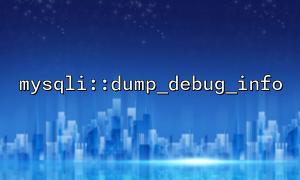mysqli::dump_debug_info is a method provided by the mysqli extension in PHP. This method retrieves debug information related to a MySQL connection, including errors, warnings, and other useful details about the connection process. Developers can use this method to easily access detailed information about MySQL connections, which helps in quickly identifying the root cause of any issues.
Calling this method does not affect database operations; it simply provides a useful debugging tool typically used during development and troubleshooting stages.
To use mysqli::dump_debug_info, you first need to create a MySQLi connection object. Then, call the dump_debug_info method to retrieve the debug information. Here is a basic example:
<?php
// Create MySQLi connection
$mysqli = new mysqli("localhost", "username", "password", "database_name");
<p>// Check if connection was successful<br>
if ($mysqli->connect_error) {<br>
die("Connection failed: " . $mysqli->connect_error);<br>
}</p>
<p>// Call dump_debug_info method to get debug information<br>
echo "<pre>";<br>
echo $mysqli->dump_debug_info();<br>
echo "// Close the connection
$mysqli->close();
?>
In this example, we first create a MySQLi connection object using new mysqli, then check for connection issues using connect_error. If no issues are found, we call dump_debug_info to output the debug information. This information can help pinpoint issues during the MySQL connection process.
The output of mysqli::dump_debug_info consists of several parts:
MySQL Server Version: Displays the version of the MySQL server currently connected to.
Connection Information: Provides details about the connection to the MySQL server, including connection time, client, and server information.
Error Information: If there is a connection failure or other issues, error messages will be shown here. This is useful for identifying MySQL connection problems.
Warning Information: In addition to errors, warnings will also be displayed, helping developers identify potential database issues.
For example, the output may look like this:
# Server: MySQL 8.0.22
# Connection ID: 123456
# Connect Time: 2025-06-07 10:30:15
# Client: mysql_native_password
# Last Error: 1045 Access Denied for user 'username'@'localhost' (using password: YES)
# Warnings: None
From this information, we can see the MySQL version, connection time, connection type, and most importantly, the error message. For example, if an authentication problem occurs, the Last Error will show an Access Denied error, which helps us determine if it's a username/password issue or a permissions problem.
Once we have the debug information from mysqli::dump_debug_info, we can often use the following strategies to resolve the issues:
Check if the database connection settings are correct, including:
Hostname: Ensure that the MySQL server's hostname or IP address is correctly specified.
Username and Password: Make sure the database username and password are correct, especially with regard to case sensitivity and any spaces.
Database Name: Confirm that the correct database name is specified.
If an Access Denied error occurs, it is usually due to insufficient user permissions. You can grant privileges to the user in MySQL using the following command:
GRANT ALL PRIVILEGES ON database_name.* TO 'username'@'localhost' IDENTIFIED BY 'password';
FLUSH PRIVILEGES;
This command will grant the specified user all privileges on the specified database.
If the dump_debug_info output shows a connection timeout or server unavailability, it could be due to the MySQL server not running, or a firewall or network issue. You can try connecting to the MySQL server directly using a command-line tool to verify if the connection is possible.
If you see any unclear error or warning messages in the dump_debug_info output, you can check the MySQL error logs for more details. This can often help identify more complex configuration problems.
mysqli::dump_debug_info is a powerful debugging tool that helps developers quickly locate and resolve issues related to MySQL connections. By calling this method, developers can obtain detailed connection debugging information, which allows them to solve MySQL connection issues more efficiently. Using this tool promptly when encountering connection errors during development can significantly reduce debugging time and improve productivity.


